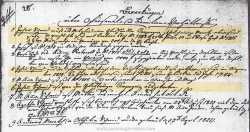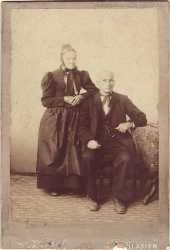 |

Example of a journey
– Glass bearer / Lenzkirch (southern Black Forest)
For the travel itinerary we have taken glass bearer, Johann Schmid from Raitenbuch (modern Lenzkirch). The profession “glass bearer” makes us curious to find out more.
The trade of glass bearer is nearly forgotten, but is remembered by a hiking trail in the southern Black Forest. The so called “Glastraegerweg” (Glass bearer trail) was opened few years ago (Landratsamt Waldshut, 2001).
|
|
|

Parts of „House-, Family and Personal record in parish of Guendelwangen, recorded in November 1813 and corrected in September 1815 by Pater Mayer”
(EAF, church book – micro film, Guendelwangen)
|
|

|
Clocks are still made in the Black Forest, just as they were in the last centuries. However, long before people began to make clocks, glass was produced in the densely wooded, but agriculturally poor areas. Many local field and village names are derived from this industry, e.g. Altglashuette, Huettenmoor, Glaserhof. In its heyday in 14th/15th centuries, glassblowers from as far afield as Bavaria, Bohemia, Silesia and Tyrol settled in the Black Forest.
Finally, in the 16th century, the trades became specialised to glassblowers, who were craftsmen and glass bearers, who were merchants. Glass bearers carried the goods to the customers. In the early 18th century, glass bearers became more influencial and secured more rights for themselves. Simultaneously, the first glass bearer “Compagnie”, a kind of cooperative, was founded. Thus it became possible to organize and sell the wares more effectively and profitably.
|
Around 1740, the cooperatives were split into individual groups, each group taking the name of the area to which they delivered the glass products: Rhineland bearer, Alsace bearer, Switzerland bearer, Swabian bearer, Wuerttemberg bearer.
At the beginning of the 19th century, the headquarters of all glass bearer cooperatives was Lenzkirch, where the annual general meeting took place (Tritscheller, 1922).
About 100 years later, most of the glass industry closed down. New production methods were no longer based on wood but rather on hard coal and industrially produced soda. Competition and poor infrastructure ended the business and trade.
|
 |

Black Forest couple in Sunday clothes at the photographers (St. Blasien about 1900)
|
Below you will find several suggestions which might be included in a one- or several-day journey:
- hiking on “Glastraegerweg“ together with a guide who will bring the trade of glass bearer avidly back to life for you
- sight-seeing at the headquarters of all the glass bearer cooperatives
- sight-seeing at an early glass-factory which was in operation for 200 years
- visiting a "Roman“ cathedral right in the middle of the Black Forest
- visiting a traditional brewery including the brewery-inn
- Hotzenwald: "Klausenhof Museum“ from 15th century, see a glass-blower's work
- Todtmoos-Glashuette: find out what’s behind the "Glasmaennle” (little man of glass)
- not only glass and clocks, but also wood used to be exported from Black Forest: view the ancient trade of wood rafting
- travel by train from Titisee-Neustadt to Freiburg im Breisgau through the romantic Hoellental
- Todtmoos: see the underground treasures
- Schluchsee: sight-seeing at power-station, boat trip on Lake Schluchsee
- Feldberg: hiking with a ranger to the Feldbergsee
- unique train-journey with the "Sauschwaenzle-Bahn“ – superb example of 19th century railroad engineering technology
- hiking through the wild canyon of the River Wutach
- driving through the lovely Black Forest landscape by horse and coach
- while visiting a show garden, learn more about what people in the Black Forest ate and lived on in old days
|
 |



